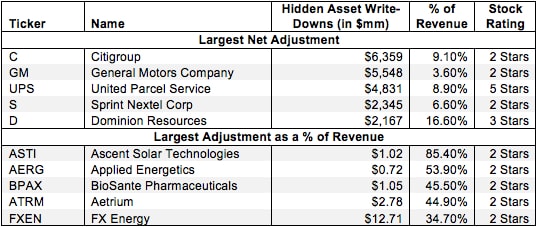This report is one of a series on the adjustments we make to convert GAAP data to economic earnings.
Reported earnings don’t tell the whole story of a company’s profits. They are based on accounting rules designed for debt investors, not equity investors, and are manipulated by companies to manage earnings. Only economic earnings provide a complete and unadulterated measure of profitability.
Converting GAAP data into economic earnings should be part of every investor’s diligence process. Meeting the challenge of performing detailed analysis of footnotes and the MD&A is a fiduciary responsibility.
We’ve performed unrivaled due diligence on 5,500 10-Ks every year for the past decade.
Asset write-downs are unusual charges that don’t appear on the income statement because they are bundled in other line items. Without careful footnotes research, investors would never know that these non-recurring items distort operating earnings by overstating core-operating costs.
Our models remove this distortion to reveal a company’s recurring, core-operating profitability or NOPAT.
Write-downs are also a form of shareholder equity destruction as they artificially reduce the carrying value of assets reported on the balance sheet. In turn, they also artificially boost profitability metrics like return on assets by lowering the denominator. Our models always capture the after-tax value of asset write-downs in our measure of invested capital, the denominator in our return on invested capital (ROIC) calculation.
This report focuses on the impact of hidden asset write-down expenses on net operating profit after tax (NOPAT), the numerator in our ROIC calculation. A future article will focus on its effects on invested capital. We will also dedicate another report to other (non-write-down) unusual items hidden in operating earnings.

4 replies to "Asset Write-Downs Hidden In Operating Earnings – NOPAT Adjustment"
Quick question. How do your analysts account for a company that is currently well-managed (say a new mgt team, strategy, etc.) versus prior mistakes by C-level execs. For example, large write-downs added back (after tax) to invested capital will be baggage forever-Right? However, a “clean-slate” mgt team may actually be generating an attractive ROIC–but doesn’t show up due to the excessively large denominator. In other words, can you track real-time ROIC that excludes past mgt mistakes? It could take years for this to show up in an acceptable ROIC. Probably not an often enough occurrence to dictate your attention, but just curious. BTW–love the work you guys do.
thx
JB
Good question JB. This is a question we’ve considered many times and continue to evaluate. For now, we’ve decided to add back all accumulated write-downs back to invested capital, but with enough transparency in our models and reports that investors can see the impact of these write-downs and make their own decisions on how to treat them.
Hi Sam, I do a bit of equities research in my own time, but I dont analyse financial statements anywhere near to the level of detail you guys do. I would like to get to your level however, and I’d be very interested to know of any books or other resources which you have found useful, specifically with regards to adjusting earnings numbers to the more real earnings numbers. At the moment I’ve got financial shenanigans and Quality of Earnings, but I was hoping you would have other suggestions that might improve my analysis of financial statements.
Cheers,
Eddie
Eddie,
I would recommend reading anything you can find by Michael Mauboussin, including his book “The Expectations Game” and his white papers that you can find here:
http://www.valuewalk.com/2015/12/michael-mauboussin-research-papers-from-credit-suisse-full-collection/
Also check out David Trainer’s chapter “Modern Tools For Valuation” in The Valuation Handbook.